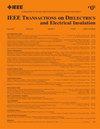Hybrid Deep Learning Models for Enhanced Classification of Phase-Resolved Partial Discharge Patterns From High-Voltage Rotating Machine Insulation
IF 3.1
3区 工程技术
Q2 ENGINEERING, ELECTRICAL & ELECTRONIC
IEEE Transactions on Dielectrics and Electrical Insulation
Pub Date : 2025-02-14
DOI:10.1109/TDEI.2025.3542343
引用次数: 0
Abstract
Partial discharge (PD) monitoring plays a crucial role in identifying insulation defects in high-voltage rotating machinery, where accurate classification is essential for improving the reliability and efficiency of condition-based maintenance (CBM). This work proposes hybrid convolutional neural network (CNN) models to classify phase-resolved PD (PRPD) patterns from six different defects in a rotating machine insulation. Various hybrid models were evaluated by integrating CNN with machine learning (ML) algorithms, which include support vector machines (SVMs), k-nearest neighbors (KNNs), logistic regression (LR), decision trees (DTs), random forests (RFs), and naive Bayes (NB). The results reveal that all proposed hybrid models consistently outperform CNN in terms of computational efficiency, by achieving an average accuracy of 94.87% across all models using two optimizers, ADAM and stochastic gradient descent with momentum (SGDM). Notably, CNN-RF (CNN-RF) and CNN-KNN (CNN-KNN) models achieve the best performance, with an accuracy exceeding 96% with lower computational time compared to CNN, which only achieves 94.44% accuracy. Thus, this work provides valuable insight into enhancing PRPD classification with lower computational cost while increasing the classification accuracy of PRPD patterns from rotating machine insulation.基于混合深度学习模型的高压旋转电机绝缘相位分辨局部放电模式增强分类
局部放电(PD)监测在识别高压旋转机械绝缘缺陷中起着至关重要的作用,准确分类是提高状态维修(CBM)可靠性和效率的关键。这项工作提出了混合卷积神经网络(CNN)模型,用于从旋转机器绝缘的六种不同缺陷中分类相位分辨PD (PRPD)模式。通过将CNN与机器学习(ML)算法(包括支持向量机(svm)、k近邻(KNNs)、逻辑回归(LR)、决策树(dt)、随机森林(rf)和朴素贝叶斯(NB))相结合,评估了各种混合模型。结果表明,所有提出的混合模型在计算效率方面始终优于CNN,通过使用两个优化器ADAM和随机梯度下降(SGDM),所有模型的平均准确率达到94.87%。值得注意的是,CNN- rf (CNN- rf)和CNN- knn (CNN- knn)模型的性能最好,与CNN相比,准确率超过96%,计算时间更短,准确率仅为94.44%。因此,这项工作为以更低的计算成本增强PRPD分类提供了有价值的见解,同时提高了旋转机器绝缘PRPD模式的分类精度。
本文章由计算机程序翻译,如有差异,请以英文原文为准。
求助全文
约1分钟内获得全文
求助全文
来源期刊
CiteScore
6.00
自引率
22.60%
发文量
309
审稿时长
5.2 months
期刊介绍:
Topics that are concerned with dielectric phenomena and measurements, with development and characterization of gaseous, vacuum, liquid and solid electrical insulating materials and systems; and with utilization of these materials in circuits and systems under condition of use.

 求助内容:
求助内容: 应助结果提醒方式:
应助结果提醒方式:


